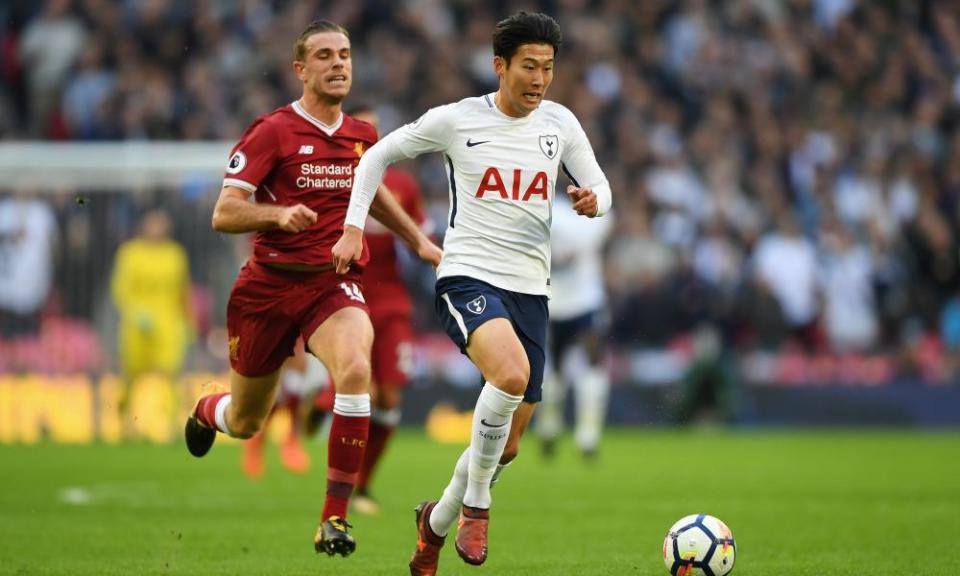Tottenham show José Mourinho how counter-attacking game should work | Jonathan Wilson

Mauricio Pochettino had promised further surprises after his deployment of a 5-3-2 against Real Madrid, but perhaps the biggest surprise was that he kept the shape the same. There were other unusual aspects to the win – Tottenham Hotspur had not been ahead against Liverpool since March 2013, Harry Kane had not previously scored a league goal at Wembley and Spurs, at last, looked at ease in their new home – but none of those particularly came as a shock.
Neither, in truth, did Liverpool’s defending. Two goals were conceded to simple balls in behind them, at least two more could have been, and two other goals came from the thoroughly predictable source of half-cleared set-plays.
Tottenham’s recent record against Liverpool had been poor: Jürgen Klopp’s side were one of only two teams to avoid defeat at White Hart Lane last season, and they had been unbeaten in their past 10 meetings against Spurs. Pochettino’s selection was perhaps a reaction to that as he selected a back three for the first time against Liverpool.
The rule of thumb for sides who play the sort of pressing football Tottenham do is to field one defender more than the opposition has forwards: that is, a back four against a front three.
Playing three central defenders and two wing-backs was a risk, potentially offering space for Liverpool’s wide men, Philippe Coutinho and Mohamed Salah, to exploit on the flanks. That was a particular concern given Serge Aurier was handed an unfamiliar role on the left. Pochettino said that was to combat Salah’s habit of cutting in but the last time he started a league game on the left was for Toulouse in a 3-1 win over Valenciennes in May 2014, and even then he was playing in midfield. But the spirit of adventure was rewarded.
Where last season’s clashes were open, even games between two sides who sought to press, here Spurs sat off, had only 36% possession and overwhelmed Liverpool. Whatever space there may have been behind Tripper and Aurier, there was far more behind Dejan Lovren. The Croatian seemed anxious and unsettled from the off and it was a mercy when he was taken off after 31 minutes for Alex Oxlade-Chamberlain. Five times in that first half-hour Spurs players found themselves behind the Liverpool back line.
Twice they scored, once Son Heung‑Min hit the bar, once his attempt to feed the ball square to Kane was cut out and once he scuffed a shot straight at Simon Mignolet after Dele Alli’s through-ball had sliced Liverpool apart.
Simply to blame Lovren, though, would perhaps be unfair. The common defence of Klopp when the defensive shortcoming of his side are mentioned is that Liverpool keep being undone by individual errors, something that is now frustrating Klopp to the point that he highlighted the “presents” Liverpool gave Spurs and claimed that the first goal was so easy to defend that it would not have been conceded had he been on the pitch, even if he had just been wearing trainers.
The question then is why so many different defenders are so prone to individual errors when they play for Liverpool. Lovren, after all, was reliable enough at Southampton. The suspicion must be that the lack of protection given to the defence – first by Steven Gerrard and now by Jordan Henderson, both fine marauding players but not natural holders – is creating problems, not only from a structural point of view but also in terms of scrambling brains.
Pochettino had gambled on exploiting Liverpool’s defensive vulnerabilities and had been vindicated; the contrast to José Mourinho’s approach at Anfield could not have been more pronounced.
Klopp had spoken then of his delight at how his side had countered the counter, but every time Tottenham won the ball back they looked like creating a chance.
What Liverpool had been countering, it seems, was the Mourinho mirage of a counter, a threat that existed more in theory than in actuality. Faced with the real thing, yet again, Liverpool crumbled – and so, too, did the rationale behind Mourinho’s timorousness.
Pochettino’s selection was a gamble, however, and the risk of that was exposed with Liverpool’s opener as Kane was dispossessed and Henderson swept the ball into the space behind Aurier for Salah to run on and score.
Liverpool had plenty of other chances – many of them, admittedly, when the score was already 4-1 and the game was lost. That openness may, in the longer term, be a concern – and Pochettino seemed less impressed by how his side had played in the second half than the first.
“When you decide to play in some way, sometimes it works sometimes it doesn’t,” he said. At the moment he seems in a happy phase when whatever he touches goes right, every surprise is a positive one. But perhaps the most promising aspect is that he now has a squad varied enough to spring those surprises, whether it is going long to a target man in Fernando Llorente, or using Son to attack the space behind the defensive line. Klopp, meanwhile, continues to wrestle with the same problems, the horribly familiar issues of defensive control.

 Yahoo Sport
Yahoo Sport 





































